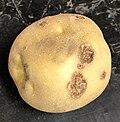Common scab
Common scab is a plant disease that primarily affects potatoes, but can also impact other tuberous and root crops such as beets and carrots. The disease is caused by various species of the genus Streptomyces, with Streptomyces scabies being one of the most common pathogens associated with common scab. This bacterial infection is characterized by the appearance of scabby lesions on the skin of the tubers, which can affect the crop's marketability and, in severe cases, reduce yield.
Symptoms
The primary symptom of common scab is the appearance of corky, rough patches or lesions on the surface of the tuber. These lesions can vary in size and depth, ranging from superficial blemishes to deep pitted areas. The severity of the symptoms can be influenced by environmental conditions, particularly soil moisture and pH levels, with the disease thriving in alkaline, well-drained soils.
Causative Agent
Common scab is caused by several species of Streptomyces, a genus of Gram-positive bacteria. These bacteria are soil-dwelling organisms that infect tubers through wounds or natural openings. Once established, they produce toxins that lead to the formation of the characteristic scab lesions.
Management
Management of common scab involves an integrated approach combining cultural, biological, and chemical strategies:
- Cultural Practices: Maintaining optimal soil moisture during the tuber initiation and development stages can help reduce the incidence of common scab. Crop rotation with non-host crops and the use of resistant potato varieties are also effective cultural practices.
- Biological Control: Some beneficial soil organisms can suppress Streptomyces populations, thereby reducing the incidence of common scab.
- Chemical Control: The use of soil fumigants and other chemical treatments can be effective but is often considered a last resort due to environmental concerns and the potential for developing resistance.
Economic Impact
While common scab does not typically result in significant yield losses, it can substantially reduce the market value of affected crops due to the unsightly appearance of the lesions. This is particularly true for potatoes intended for the fresh market, where visual appearance is a key factor in consumer choice.
Prevention
Preventative measures include the selection of resistant varieties, proper irrigation management to avoid overly dry soil conditions, maintaining a neutral soil pH, and practicing good crop rotation to reduce the buildup of pathogenic Streptomyces in the soil.
This article is a agriculture stub. You can help WikiMD by expanding it!
Transform your life with W8MD's budget GLP-1 injections from $125.
W8MD offers a medical weight loss program to lose weight in Philadelphia. Our physician-supervised medical weight loss provides:
- Most insurances accepted or discounted self-pay rates. We will obtain insurance prior authorizations if needed.
- Generic GLP1 weight loss injections from $125 for the starting dose.
- Also offer prescription weight loss medications including Phentermine, Qsymia, Diethylpropion, Contrave etc.
NYC weight loss doctor appointments
Start your NYC weight loss journey today at our NYC medical weight loss and Philadelphia medical weight loss clinics.
- Call 718-946-5500 to lose weight in NYC or for medical weight loss in Philadelphia 215-676-2334.
- Tags:NYC medical weight loss, Philadelphia lose weight Zepbound NYC, Budget GLP1 weight loss injections, Wegovy Philadelphia, Wegovy NYC, Philadelphia medical weight loss, Brookly weight loss and Wegovy NYC
|
WikiMD's Wellness Encyclopedia |
| Let Food Be Thy Medicine Medicine Thy Food - Hippocrates |
Medical Disclaimer: WikiMD is not a substitute for professional medical advice. The information on WikiMD is provided as an information resource only, may be incorrect, outdated or misleading, and is not to be used or relied on for any diagnostic or treatment purposes. Please consult your health care provider before making any healthcare decisions or for guidance about a specific medical condition. WikiMD expressly disclaims responsibility, and shall have no liability, for any damages, loss, injury, or liability whatsoever suffered as a result of your reliance on the information contained in this site. By visiting this site you agree to the foregoing terms and conditions, which may from time to time be changed or supplemented by WikiMD. If you do not agree to the foregoing terms and conditions, you should not enter or use this site. See full disclaimer.
Credits:Most images are courtesy of Wikimedia commons, and templates, categories Wikipedia, licensed under CC BY SA or similar.
Translate this page: - East Asian
中文,
日本,
한국어,
South Asian
हिन्दी,
தமிழ்,
తెలుగు,
Urdu,
ಕನ್ನಡ,
Southeast Asian
Indonesian,
Vietnamese,
Thai,
မြန်မာဘာသာ,
বাংলা
European
español,
Deutsch,
français,
Greek,
português do Brasil,
polski,
română,
русский,
Nederlands,
norsk,
svenska,
suomi,
Italian
Middle Eastern & African
عربى,
Turkish,
Persian,
Hebrew,
Afrikaans,
isiZulu,
Kiswahili,
Other
Bulgarian,
Hungarian,
Czech,
Swedish,
മലയാളം,
मराठी,
ਪੰਜਾਬੀ,
ગુજરાતી,
Portuguese,
Ukrainian
Contributors: Prab R. Tumpati, MD


